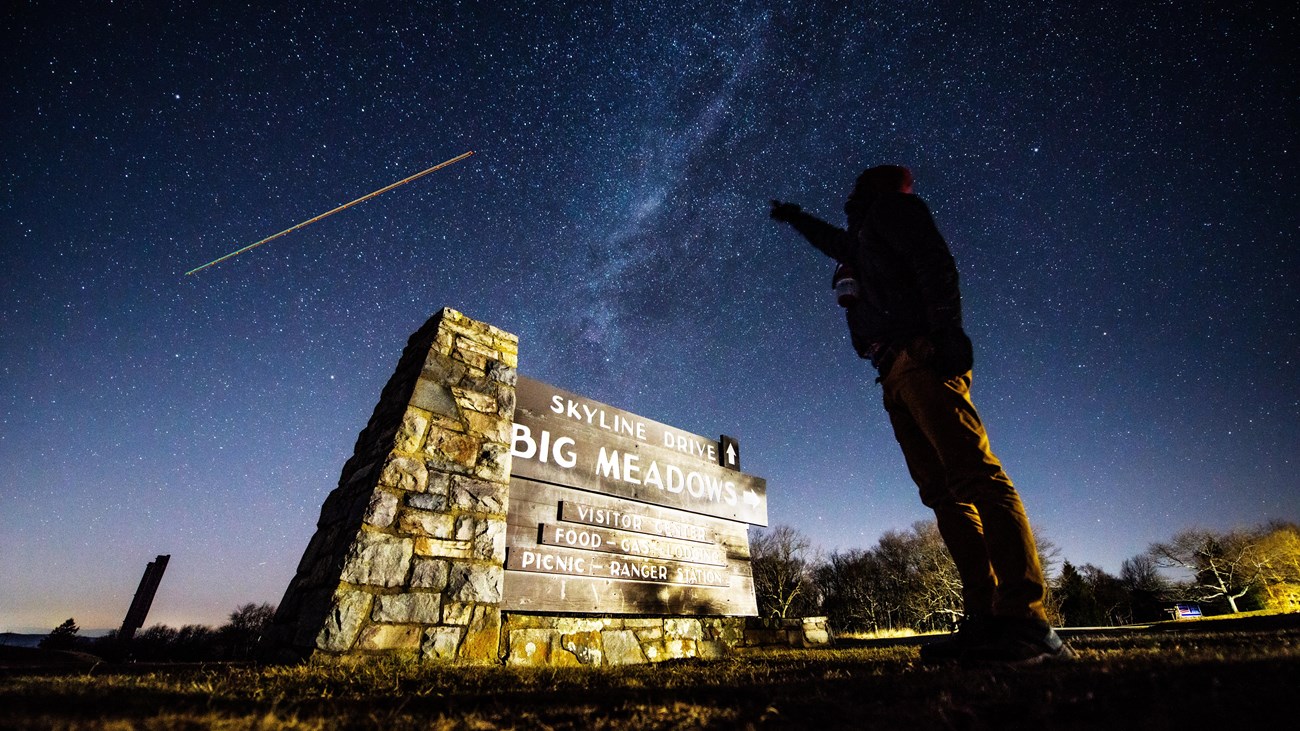Last updated: February 26, 2021
Thing to Do
Stargaze in Shenandoah

Shenandoah National Park has distinctly accessible night skies that make stargazing and astrophotography a fun and insightful activity for all ages. From our dark sky, you can gaze upon the clouds of dust and gas in Orion’s belt, watch Earth’s GPS satellites whiz above, see the glow of the Milky Way Galaxy, catch shooting stars crashing into our atmosphere, watch the planets orbit the sun, find the 88 constellations that fill the night sky...and so much more!
Why Shenandoah?
Shenandoah is uniquely positioned and equipped to give an astronomical dark sky experience. Aside from winter closures due to snow and ice, the Skyline Drive is accessible 24 hours a day, 7 days a week, and has enough elevation to get you away from much of the light pollution produced by the towns and cities in the valley below.
Where should I stargaze?
One of the most popular places to view the night sky in the park is Big Meadows. One of the higher points in the Park, the unique bowl shape and expansive overhead views make it an ideal location. In addition to this popular spot, many overlooks along Skyline Drive also provide beautiful scenery of the towns below and night skies above.
What do I need to do to prepare?
Not every night is good for stargazing. In fact, most nights aren’t ideal. Nobody wants to excitedly drive into the Park and look up to see nothing but the faint orange glow caused by a cloudy night. When it comes to stargazing, mother nature is under no obligation to make your Friday night a pleasant experience! That’s why it’s vital to check the weather before you go in order to make sure it’s worth your time. Here are a few questions to find the answers to before you leave the house:
-
Are there clouds tonight? Clouds are the number one obstacle to seeing the stars. Check cloud cover radar to see what kind of systems are in the viewing area.
-
Am I going to a location with a dark sky? Big Meadows is about as dark of a sky as you can find for hundreds of miles in any direction. There are darker skies in West Virginia, but they’re often more isolated or farther away from population centers. Wherever you are in the world, you can search online for light pollution maps that will help you find a dark site. Doing so also gives a good perspective on how few dark skies are left in our world!
-
Is it a new moon? The darker the sky, the more stars you can see. One of the biggest light sources at night is a full moon. It washes away your night vision and drowns out the view of stars in a huge section of the sky around it. Try your best to go in the monthly three to five day period when the moon is dark or “new”, the opposite of "full," so that the sky will be dark.
-
Is it going to be too cold or windy? Temperatures drop at night and can be ten degrees cooler on the mountain than they are in the valley below. Be sure to check local weather forecasts and bundle up!
-
Do I have the right equipment? While the only thing you need are your eyes, there are other tools that can enhance your experience. Don’t forget a light source to help you get set up! Any light will work, but a red light will reduce the impact on your night vision. For beginners, the best tool is one of the many stargazing apps available on your phone. They allow you to quickly and easily learn more about what you’re looking at. Binoculars, a viewing scope, or, better yet, a telescope, will help you see even further into space. A camera with a manual shutter can help you to capture amazing photos of the night sky. A chair, blanket, and a warm drink can also help make your night more enjoyable.
What can I expect?
Stargazing gives us the opportunity to discover what many people have already learned: half of Earth's beauty happens when the sun is on the other side of our planet. That’s when we can see the other stars that make up the universe. That is when we can find our own place in the universe and a deeper meaning to our lives here. Stargazing can be a profoundly humbling, awe-inspiring, and serene activity. It gives us the chance to ask ourselves big questions, like: what life forms are orbiting those stars? What did our ancestors think when they gazed up at night? What stories did they tell about the patterns they saw? How did they use these stars? Who will be that first astronaut to visit one of those stars? What will they find there?
Where allowed, pets must be kept on a physical leash no longer than 6 feet at all times.
An entrance fee is required to get into Shenandoah National Park.
